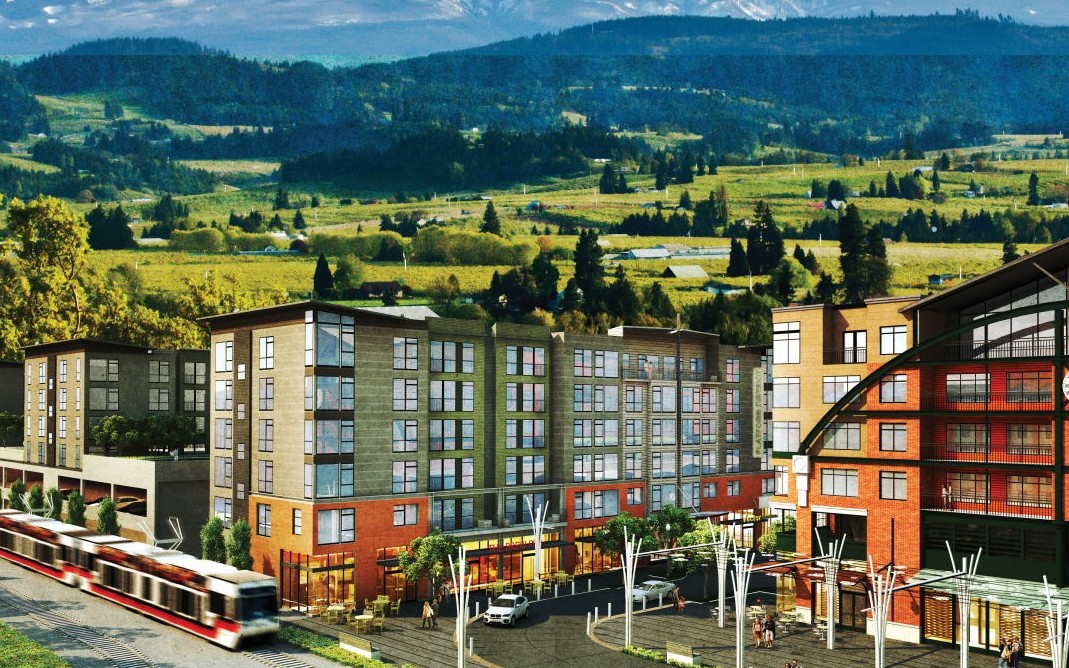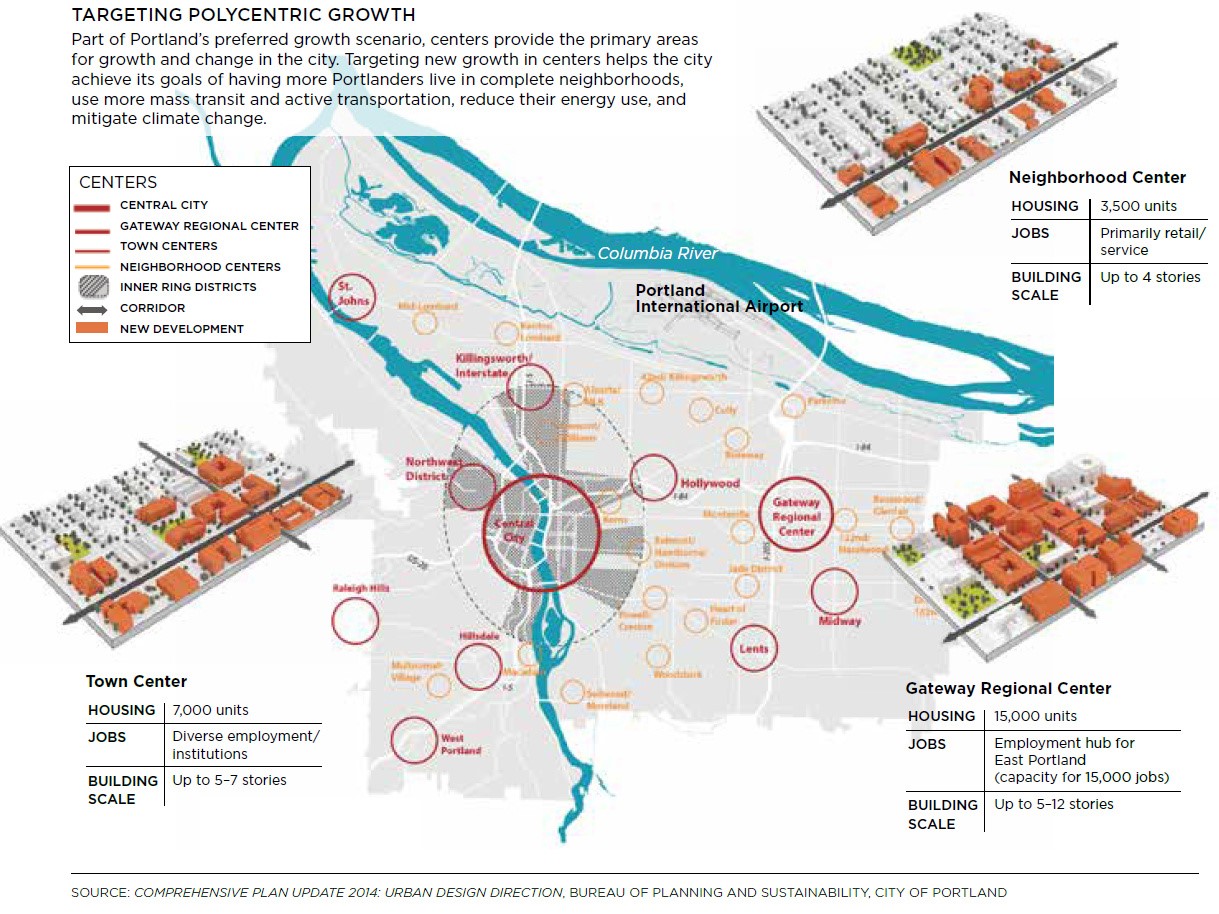Shima Hamidi, a former doctoral student of mine and now assistant professor at the University of Texas at Arlington, may be the most prolific young planning academic in the country. A year and a half after graduation, she already has 24 articles published in many of the leading journals and another eight under review. Much of her research relates directly or indirectly to polycentric development. It’s a topic that I’ve been thinking quite a bit about lately.

This emerging regional planning paradigm in the United States is exemplified by Portland, Oregon. It concentrates development in centers connected by high-quality transit. Portland has a stellar reputation for good planning, of course, and that’s thanks in large part to the 2040 Growth Concept. Way back in the early 1990s, thousands of Oregonians helped shape a 50-year plan for the metropolitan area.
The 2040 Growth Concept was groundbreaking for its early application of scenario planning, in which three scenarios were compared:
1. “growing out” (sprawl)
2. “growing up” (infill)
3. “neighboring cities” (polycentric)
The last two outperformed sprawl in terms of land consumption, air quality, traffic congestion, and many other outcome measures, and a combination of those infill and polycentric scenarios are what the Metro Council adopted in 1995. That explicit focus on, and pro-motion of, polycentric development was also pioneering. The plan designated a hierarchy of centers served by high-quality transit. There was—and still is—downtown Portland, the central city; seven regional centers (such as downtown Hillsboro on the metro area’s west side); 30 town centers (for example, Hillsboro’s Orenco Station opened in the 1990s); and even more neighborhood centers and transit station communities.
The research
With Portland on my mind, as well as Hamidi’s new research (more on that in a minute), I had my research assistants review more than 100 regional transportation plans to see if polycentric development, a la Portland, has in fact become the dominant regional development paradigm in the U.S. Indeed, it has. The students searched the RTPs for the keyword “centers.” Synthesizing the quantitative criteria found in 25 of those RTPs and the qualitative criteria found in all plans, they identified the following hierarchy of centers as most common: regional centers, town centers, neighborhood centers, and transit-oriented developments. Most often these centers are or will be connected by high-quality transit, so the dominant paradigm has a strong transit component too.
Two things surprised us regarding the treatment of centers in RTPs. One was the general absence of quantitative criteria for designating centers. They lacked criteria regarding minimum center densities and intensities of development; minimum population, employment, or land areas; target land-use mixes; and recommended transit service types or levels. Without this type of roadmap, how does an MPO know when it “gets there”? I should mention that a few did it well. Look to Austin, Chattanooga, and Minneapolis for examples of notable measurement criteria in their regional transportation plans.

The other surprise was the absence of any quantification of the benefits of polycentric development over sprawl. It is taken on faith that polycentric development is superior, but faith can be tested. Which brings me back to Shima Hamidi’s body of work in this area.
In one article, under review at Land-scape and Urban Planning, Hamidi has identified major employment centers in 374 metropolitan areas and divisions. She used geographically weighted regression to identify local employment density peaks along a density gradient starting at the CBD and dropping off from there. She excluded cases containing large employers such as hospitals, shopping malls, and universities with more than 75 percent of the block group employment. She also excluded potential candidates if the ratio of employment to population was less than 2.5, thereby requiring centers to have a mix of uses. Her study found that 224 MSAs are monocentric, 18 are dispersed with no significant centers, and only 132 are polycentric.
That is depressing, if polycentric development is indeed superior in most cases to either monocentric development or sprawl. Hamidi’s criteria may have been a bit too demanding, but looking at my own home MSA, Salt Lake City, they do not seem unreasonable. Salt Lake City is monocentric, a conclusion you will reach upon flying into the city to go skiing and seeing only one significant concentration of mid- and high-rise development (our downtown).
Hamidi’s methodology seems to have mostly identified the major subcenters but missed the minor ones. In Salt Lake City, we may have only one major center, but we have identified 18 mixed use developments or mixed use districts that might be classified as minor centers and might, in addition, form the nuclei for future major centers. Our suburban municipality of Sandy, for example, has plans for a mid- to high-rise city center between light rail and commuter rail lines. Even Portland only has three centers, according to Hamidi’s methodology. Based on that, I think Hamidi’s LAND paper is just the first step in identifying centers and subcenters nationwide.
Bringing it all together
So what are most metropolitan areas with monocentric or uncentered development missing out on? Meijers and Burger found that polycentricity—as opposed to monocentricity—is associated with higher labor productivity. Others argue that polycentricity—as opposed to sprawl—more efficiently organizes economic activities because it concentrates firms, allowing them to connect with each other, customers, and supplies effectively. A few empirical studies have tested these theories about polycentricity. But these studies focus exclusively on particular big cities such as Los Angeles and Chicago, which seriously limits the generalizability of their findings. Even small cities can have town and neighborhood centers.
Here is where Hamidi’s research comes in. A 2015 article published in the Journal of Planning Education and Research shows that walk and transit mode shares on com-mute trips are significantly higher in centered than sprawling metropolitan areas. Her research in many other articles and journals shows that compact development generally outperforms sprawl in terms of everything from air quality to traffic safety to upward social and economic mobility. So that, planners working in other metropolitan areas, is what you are missing out on.
About the Author: Reid Ewing is chair of the Department of City and Metropolitan Planning at the University of Utah, an associate editor of the Journal of the American Planning Association, and an editorial board member of the Journal of Planning Education and Research and Landscape and Urban Planning.

